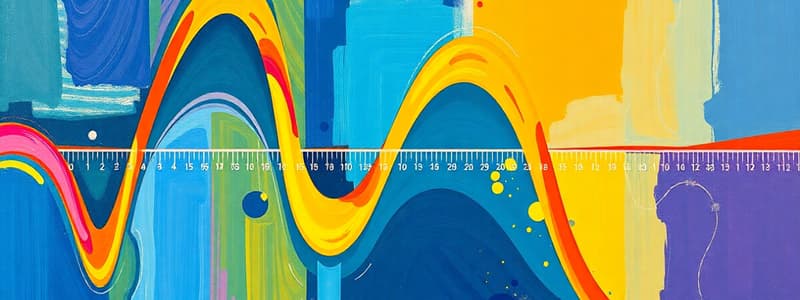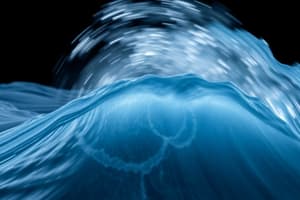Podcast
Questions and Answers
How is loudness related to sound waves?
How is loudness related to sound waves?
- Larger amplitude results in softer sound.
- Loudness only depends on frequency.
- Larger amplitude results in louder sound. (correct)
- Loudness is independent of amplitude.
What occurs when sound waves change direction as they move between different media?
What occurs when sound waves change direction as they move between different media?
- Diffraction
- Refraction (correct)
- Interference
- Reflection
Which of the following statements about waves is true?
Which of the following statements about waves is true?
- Waves do not change direction when they encounter obstacles.
- Waves cannot spread out as they pass through openings.
- Waves can bounce back and create echoes. (correct)
- Waves always travel slower in water than in air.
What does an oscilloscope measure in sound waves?
What does an oscilloscope measure in sound waves?
Which formula represents the relationship between wave speed, frequency, and wavelength?
Which formula represents the relationship between wave speed, frequency, and wavelength?
What is the relationship between frequency and time period for a wave?
What is the relationship between frequency and time period for a wave?
What is the unit of measurement for frequency?
What is the unit of measurement for frequency?
In a longitudinal wave, the particles of the medium move:
In a longitudinal wave, the particles of the medium move:
What does the wavelength of a wave represent?
What does the wavelength of a wave represent?
Which equation relates wave speed, frequency, and wavelength?
Which equation relates wave speed, frequency, and wavelength?
Sound waves are characterized by which of the following properties?
Sound waves are characterized by which of the following properties?
What is the frequency range of human hearing?
What is the frequency range of human hearing?
What is the maximum displacement of particles from their resting position called?
What is the maximum displacement of particles from their resting position called?
Flashcards
Amplitude
Amplitude
The height of a sound wave, determining how loud it sounds. Larger amplitude means a louder sound.
Reflection
Reflection
The bouncing back of waves when they encounter a surface. Think of echoes.
Refraction
Refraction
The bending of waves as they pass from one medium to another. This happens because waves travel at different speeds in different materials.
Diffraction
Diffraction
Signup and view all the flashcards
Oscilloscope
Oscilloscope
Signup and view all the flashcards
Frequency
Frequency
Signup and view all the flashcards
Time Period
Time Period
Signup and view all the flashcards
Wavelength
Wavelength
Signup and view all the flashcards
Wave Speed
Wave Speed
Signup and view all the flashcards
Longitudinal Wave
Longitudinal Wave
Signup and view all the flashcards
Transverse Wave
Transverse Wave
Signup and view all the flashcards
Sound Speed
Sound Speed
Signup and view all the flashcards
Study Notes
Wave Properties and Equations
-
Frequency (f) and Time Period (T): Frequency is the number of oscillations per second, measured in Hertz (Hz). Time period (T) is the time taken for one complete oscillation, measured in seconds (s). They are inversely related: f = 1/T or T = 1/f.
-
Wave Speed (v), Frequency (f), and Wavelength (λ): Wave speed is calculated as the product of frequency and wavelength: v = f × λ. Wave speed is measured in meters per second (m/s), frequency in Hertz (Hz) and wavelength in meters (m).
Units of Measurement
-
Degree (°): Used to measure angles, particularly in wavefront analysis.
-
Hertz (Hz): A unit of frequency, representing cycles per second.
-
Meter (m): A unit of length, used to measure wavelength.
-
Meter per second (m/s): A unit of speed, used to measure wave speed.
Wave Types and Definitions
-
Longitudinal Waves: Particles vibrate parallel to the direction of energy transfer. Sound is an example.
-
Transverse Waves: Particles vibrate perpendicular to the direction of energy transfer. Light waves are transverse.
-
Amplitude: The maximum displacement of a particle from its resting position.
-
Wavefront: A surface connecting points in a wave that are in the same phase.
-
Frequency (f): The number of oscillations per second.
-
Wavelength (λ): The distance between two consecutive corresponding points (like crests or troughs) on a wave.
-
Period (T): The time taken for one complete oscillation.
Energy Transfer by Waves
- Waves transfer energy and information without transferring matter.
Relationships Between Wave Properties
-
Wave Speed (v): v = f × λ
-
Frequency (f) and Time Period (T): f = 1/T and T = 1/f.
Sound Waves
-
Longitudinal Nature: Sound waves are longitudinal, meaning particles vibrate parallel to the direction of the wave's travel. They involve compressions and rarefactions.
-
Human Hearing Range: Humans can hear frequencies between 20 Hz and 20,000 Hz.
-
Pitch and Frequency: Higher frequency sound waves correspond to higher pitch.
-
Loudness and Amplitude: Loudness is related to the amplitude; larger amplitude corresponds to a louder sound.
Wave Behavior
-
Reflection: Waves bounce off a surface.
-
Refraction: Waves change direction when passing from one medium to another.
-
Diffraction: Waves spread out when passing through an opening or around an obstacle.
Practical Applications
- Oscilloscope: Used to display and measure various properties of sound waves, including frequency, amplitude, and time period.
Electromagnetic Spectrum (Context)
- The electromagnetic spectrum encompasses a wide range of waves, including radio waves, microwaves, infrared, visible light, ultraviolet, X-rays, and gamma rays.
Important Formulas
-
Wave Speed: v = f × λ
-
Frequency: f = 1/T
-
Time Period: T = 1/f
To read a Cathode Ray Oscilloscope (CRO), follow these steps:
1. Understand the Display
The CRO displays the waveforms of electrical signals on a screen. The wave is drawn in a graph-like form where:
- The horizontal axis (X-axis) represents time (usually in milliseconds or microseconds per division).
- The vertical axis (Y-axis) represents the voltage of the signal (usually in volts per division).
2. Adjusting Time Base (X-axis)
The time base controls how fast the signal moves across the screen. It determines how much time each division on the X-axis represents.
- A higher time base (smaller values like 1 ms/div) shows faster signals.
- A lower time base (larger values like 10 ms/div) shows slower signals.
You can adjust the time base using the "Time/Div" knob, which allows you to zoom in or out on the signal’s time span.
3. Adjusting Voltage (Y-axis)
The voltage scale controls how much voltage each vertical division represents. The "Volts/Div" knob adjusts the height of the waveform.
- A higher setting (larger values like 2 V/div) compresses the waveform vertically.
- A lower setting (smaller values like 0.2 V/div) stretches the waveform vertically.
4. Reading the Signal
Once the signal is visible on the screen, you can read it to gather information about its characteristics:
- Frequency: The number of cycles per second (Hertz, Hz) can be calculated by measuring the time period (T) of one cycle. Time period is the horizontal length of one full wave (one cycle).
- Formula: Frequency (f) = 1 / Time Period (T)
For example, if one cycle takes 2 milliseconds (ms), the frequency would be: - f = 1 / 0.002 s = 500 Hz
- Formula: Frequency (f) = 1 / Time Period (T)
- Amplitude: This is the maximum voltage reached by the signal. It is measured from the baseline (middle of the waveform) to the peak (top) or trough (bottom) of the wave.
- For example, if each division on the Y-axis represents 2 volts, and the peak reaches 4 divisions, the amplitude is:
- Amplitude = 4 × 2 V = 8 V
- Wavelength: This refers to the distance between two consecutive crests (or troughs) of the wave. On a CRO, this can be calculated by counting the horizontal divisions between two peaks and multiplying by the time base setting.
5. Using the Cursor Function
Many modern oscilloscopes have a cursor function that allows you to measure the time period and amplitude directly on the screen. You can place the cursors on the wave and the oscilloscope will automatically calculate the values for you.
6. Triggering
To get a stable waveform, the CRO has a trigger function, which synchronizes the waveform display. Adjust the trigger level to capture a steady waveform rather than a flickering one.
- Trigger level: Controls where the waveform starts.
- Trigger slope: Determines if the waveform is triggered on the rising or falling edge.
Summary
- Time Period (T) = Horizontal length of one cycle.
- Frequency (f) = 1 / Time Period.
- Amplitude = Vertical distance from the baseline to the peak or trough.
- Wavelength = Measured along the X-axis for one full cycle.
With this information, you can read and analyze the waveform displayed on the CRO! Let me know if you need further explanation.
Studying That Suits You
Use AI to generate personalized quizzes and flashcards to suit your learning preferences.




